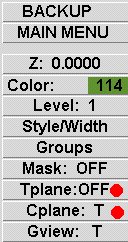
The Basics
Cplane allows you to set a flat plane, where geometry
can be created. Standard Cplane's are Top, Front, Side etc.
Tplane allows you to set a flat plane, where machining
can be performed. With Tplane you can machine on all
sides of the part.
Cplane / Tplane & Alt o (letter o, not number zero) are
used to set the Origin (zero point) for construction
and machining. This means you can float the XYZ
zero location to any point on your part

Cplane & Tplane are accessed by clicking on the button
shown at the lower part of the left menu.
They can also be selected by their hot keys.
Alt 5 is the hot key for Cplane.
Alt 4 is the hot key for Tplane.
The Setup Procedure
The first thing to do is set the Cplane & Tplane, for each
side that needs to be machined. After these are set, they
can be named and recalled as needed. Cplane & Tplane
can be accessed with selection at the lower left of the
Main Menu, or by using the Alt "hot keys".
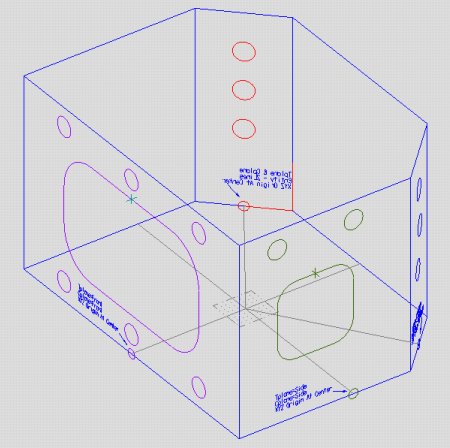
Save & unzip the sample part to your Mastercam
drawing folder and open it.
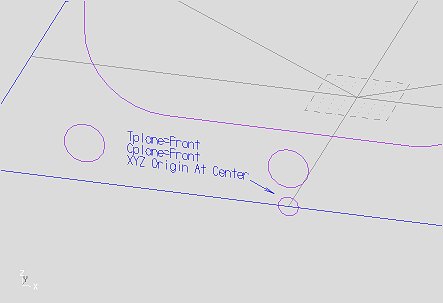
Setting Up The Front
Zoom in (F1) to get a better liew of the front of the part.
Cplane (Alt 5) - Front
Cplane (Alt 5) - Alt o (the letter), pick Center and select the
small light blue circle indicated on the front of the part.
Tplane (Alt 4) - Next menu - =Cplane
This makes the Tplane the same as the Cplane and it's origin.
Saving & Naming The Settings
Cplane (Alt 5) - Next menu - Save named
type in the name FRONT OF PART,
check the Associative box,
set the Work Offset to 0 (-1 means no work offset).
Click OK
Setting Up The Side
Cplane (Alt 5) - Side
Cplane (Alt 5) - Alt o (the letter), pick Center and select the
small dark green circle indicated on the side of the part.
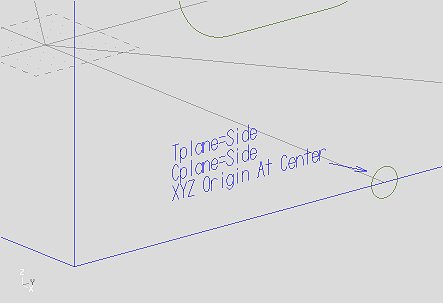
Tplane (Alt 4) - Next menu - =Cplane
This makes the Tplane = to the Cplane and it's origin.
Cplane (Alt 5) - Next menu - Save named
type in the name RIGHT SIDE OF PART,
check the Associative box,
set the Work Offset to 1.
Click OK
Setting Up The Right Back Angled Side
Rotate the part so you can see the dark blue geometry clearly.
I suggest doing a right click of the mouse, selecting Dynamic
and picking the part center as the rotation point.
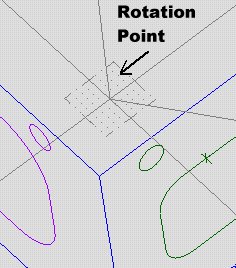
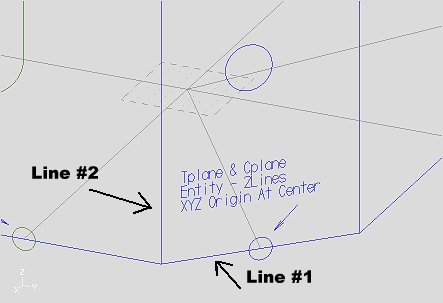
Cplane (Alt 5) - Entity - pick the two dark blue lines, selecting
the lower line first and the vertical line second (the first
represents the X axis and the second line represents the Y axis).
The screen will show a tetrahedron (XYZ axis thing).
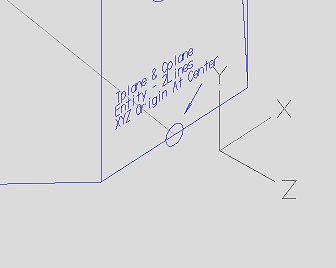
The Z axis should be pointing outside the part.
If it dosen't look like the axis shown below,
select Next. If is does look like this, select Save.
Cplane (Alt 5) - Alt o (the letter), pick Center and select the
small dark blue circle indicated on that side of the part.
Tplane (Alt 4) - Next menu - =Cplane
This makes the Tplane = to the Cplane and it's origin.
Cplane (Alt 5) - Next menu - Save named
type in the name BACK RIGHT SIDE OF PART,
check the Associative box,
set the Work Offset to 2.
Click OK
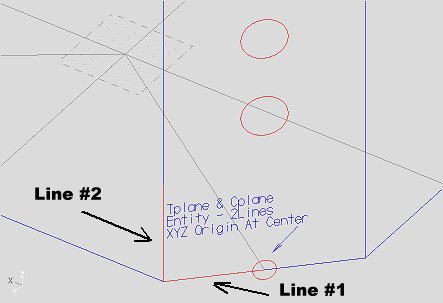
Setting Up The Left Back Angled Side
Rotate the part so you can see the red geometry clearly.
Cplane (Alt 5) - Entity - pick the two red lines, selecting
the lower line first and the vertical line second (the first
represents the X axis and the second line represents the Y axis).
The screen will show a tetrahedron (XYZ axis thing). The Z axis
should be pointing outside the part. Select Save.
Cplane (Alt 5) - Alt o (the letter), pick Center and select the
small red circle indicated on the that side of the part.
Tplane (Alt 4) - Next menu - =Cplane
This makes the Tplane = to the Cplane and it's origin.
Cplane (Alt 5) - Next menu - Save named
type in the name BACK LEFT SIDE OF PART,
check the Associative box,
set the Work Offset to 3.
Click OK
Select A Plane For Machining
To select a plane for geometry creation or toolpath, select
Cplane (Alt 5) - Next menu - Get named .
and a list of all the available (defined) planes will be shown.
Select the plane to be machined.
Create toolpaths as usual for that plane.
Mastercam will treat that plane the same
as if you were machining the top of the part.
Repeat as necessary for each side.
Horizontal Postprocessor
Most of the horizontal postprocessors I've written conform
to the standard of the Front being B0(zero). Below is a post
that I use for customizing other horizontal machines. It's what
I call my "base" post. If you have a Fanuc type control this post
should work for you. There are a number of internal "switches"
that can be turned on or off.
For more information on my screen colors check out this link.